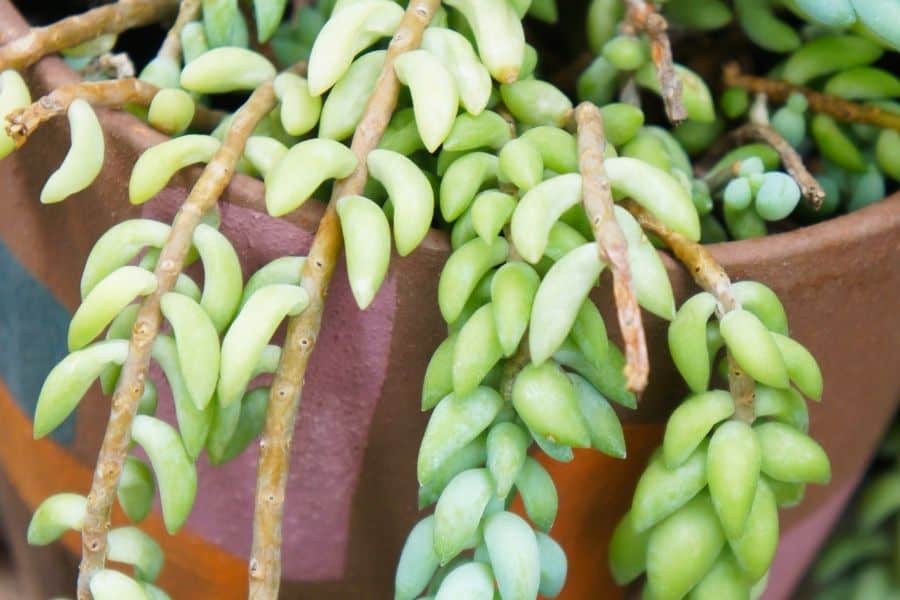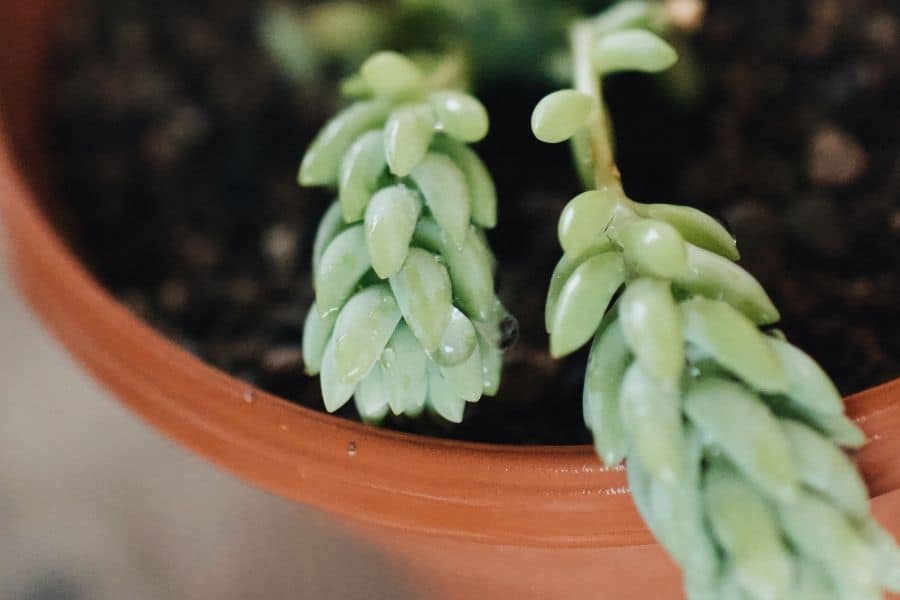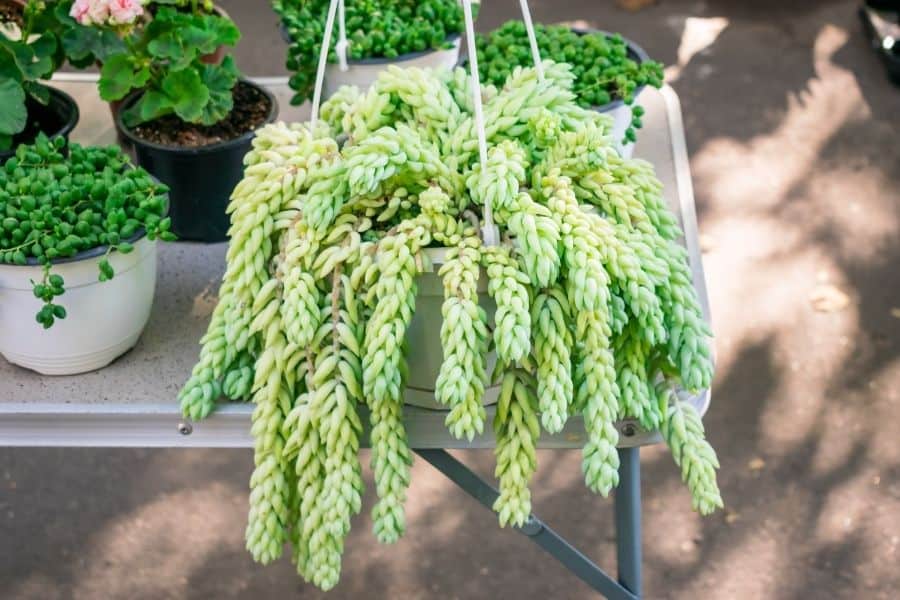Preventing Burro’s Tail Leaves from Falling Off: Causes and Solutions
The burro’s tail, also known as the donkey tail succulent, is a beautiful flowering plant that comes all the way from Mexico. People love to have it in their homes because it looks amazing when hung in gardens, and it’s pretty tough too. But here’s the catch: the leaves of the burro’s tail are really fragile.
One common concern among burro’s tail plant owners is the issue of burro’s tail leaves falling off. In this article, we’ll explore the causes behind this leafy phenomenon and unravel the secrets to keeping your burro’s tail happy and healthy. So, grab a seat and get ready to become a burro’s tail expert!

Contents
Reasons Why Burro’s Tail Leaves Fall Off
The burro’s tail, also known as the donkey tail succulent, is a tough yet delicate plant. One of the most noticeable signs of distress in a burro’s tail plant is the sight of burro’s tail dropping leaves unexpectedly. This succulent is often called the drama queen of its family because its leaves can easily fall off even with the slightest touch. While it’s relatively easy to keep this plant alive, the sight of bald patches on its vines can be quite distressing for plant parents.
The primary reason why burro’s tail leaves fall off is simply because the plant is naturally fragile. It’s perfectly normal for this plant to shed its leaves at the slightest provocation. However, there may also be other causes behind the leaf loss that require your attention. Let’s explore all the reasons why burro’s tail leaves fall off:
1. Overwatering
Like all succulents, the burro’s tail doesn’t need much water. This makes it susceptible to overwatering. To determine if you’re overwatering, pay attention to the leaves. If the leaves become wrinkled before falling off, it’s a sign that you’re likely giving the plant too much water.
2. Rotting
Root rot is a common issue that affects succulents, including the burro’s tail. It occurs when the plant is not properly repotted or when the roots remain saturated for an extended period. Root rot damages the plant and causes the leaves to fall off more easily. Check the roots of your burro’s tail to see if it’s suffering from root rot.

3. New Leaves
Sometimes, the leaves of the burro’s tail fall off because new growth is forming at the top of the plant. You don’t need to worry, though, because the fallen leaves will soon be replaced. If you notice tiny offsets when the leaves fall off, it means that the plant is active and growing.
What to Do When Burro’s Tail Is Losing Leaves
If your burro’s tail leaves are falling off, it’s important to determine the cause. Is it simply due to the plant’s fragile nature or is there a deeper issue at play?
Firstly, remember that the burro’s tail is a drought-resistant plant. It goes through a dormant period in winter when it doesn’t need any water at all. Before watering your plant, check if the soil is completely dry.
If you water the burro’s tail when the soil is still damp from the previous watering, you’re overwatering the plant, which can lead to leaf loss. To address this issue, reduce the frequency of watering and ensure that the drainage hole is not blocked.
Another thing to be cautious about is root rot. This often accompanies overwatering, as excess moisture encourages the growth of harmful bacteria that cause rot in the roots and leaves. If the soil takes a long time to dry after watering, it indicates improper drainage. Dig a little and examine the roots to determine if they’re turning brown, indicating root rot. To save the plant, carefully remove the affected parts, let the roots dry for a few days to form calluses, and repot the plant in a well-draining soil mix.
How to Prevent Burro’s Tail Leaves from Falling Off

While you can’t completely prevent the natural shedding of leaves, taking good care of your burro’s tail can reduce leaf loss and prevent common diseases like root or stem rot. Here’s how to properly care for your burro’s tail plant:
- Overwatering is a common issue for the burro’s tail. Adjust your watering schedule accordingly. Water the plant once every 20 days or once a month, depending on the climate in your area. Only water when the soil is completely dry. During the summer growing period, slightly increase the frequency to once every 10-15 days to support growth. Avoid watering during the winter dormancy period.
- Use an appropriate potting mix for your burro’s tail. A well-draining succulent soil mix allows for quick drainage while retaining enough moisture for the plant to absorb.
- Avoid exposing the burro’s tail to direct sunlight. It’s too delicate for the intense summer sun. Partial shade or direct morning sunlight is sufficient for the plant to thrive. If you notice the leaves turning pale before they fall off, reduce the plant’s sun exposure.
- Fortunately, the burro’s tail is not prone to many pests. However, it can be susceptible to an aphid infestation, which can be easily dealt with using a suitable insecticide. Keep a close eye on the plant and take prompt action if aphids are present.
Will Burro’s Tail Leaves Grow Back?
If your burro’s tail leaves fell off when you touched or moved the plant, they will likely grow back. New offsets may even start forming a day or two after the leaf shedding. The burro’s tail naturally sheds many leaves but quickly regrows them. You can even use the fallen leaves to propagate new burro’s tail plants.
However, if the leaf shedding is caused by root rot or overwatering, the leaves may not grow back unless you resolve the underlying problem. Overwatering can be easily corrected by adjusting your watering routine, finding the right schedule for your plant. In cases of stem rot, it’s necessary to remove all affected roots and repot the entire plant.
Don’t worry! Both issues are fixable. Burro’s tails are resilient plants, and with proper care, you’ll have them back to their stunning glory in no time.
